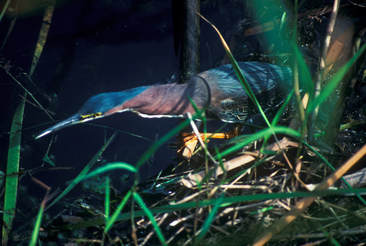
At Chickamauga Dam the water flows with the force of recent rains. It had risen on the bank, but the level is now descending. Three Osprey circle above the muddy tide and move off down river.
Several Double Crested Cormorants fly downstream low over the water. Movement seems to be downstream, away from the dam, but three crows buck the tide to fly up and over the dam.
Herons line the bank, but in smaller numbers than usual. A few fly over the water but do not land. I have seen them land on the surface and float downstream with the current. This does not seem to be a fishing technique. I don't know why they do this.
Several Tree Swallows fly above the muddy chop. One sits on a sign which says, “Warning: Dangerous Waters.”
At Chattanooga State TCC the Great Blue Herons have long deserted the nests above the creek at the west entrance. Three of them stand on emergent logs in the creek. One Green Heron poses as though for a photograph. Green Herons are usually much more secretive. Photographs of them appear at https://www.allaboutbirds.org/guide/Green_Heron/id
At Amnicola Marsh another Green Heron perches near the viewing area. The Green Heron is usually a shy bird. I count myself lucky to have observed them several times over the past few weeks. Cornell Laboratory of Ornithology lists them as common but rapidly declining.
Eleven Great Egrets and five Great Blue Herons are present today. Tree swallows are less abundant, as are Common Grackles. Red-winged Blackbirds sing from hidden perches. An Osprey circles above the pond.
The goose family is present with five young. One lone goose sits on a island by the further shore. A Carolina Wren sings as though he were king of the world but refuses to show himself.
The singing of bullfrogs has become more prolific. Other frogs have come and gone.
The blackberries are thick with blossoms. Oddly, they bloomed earlier in my neighborhood despite the higher elevation. Up there, the dogwoods have bloomed fiercely, and the redbuds have dropped their blossoms.

 RSS Feed
RSS Feed